A person riding a bicycle died after being involved in a collision with a MAX light rail train today around 1:30 pm. It happened near Southeast Division and 8th Avenue.
It appears that the bicycle rider was using the street, not the bike path. The Multnomah County Sheriff’s Office says the rider was headed north on SE 8th when they went around caution barriers that had been lowered due to the passage of a Union Pacific train.
“The cyclist rode his bike into the opposing southbound lanes of travel, where there are no crossing arms, and was subsequently hit by a MAX train traveling in the direction of Milwaukie as he crossed the railroad tracks,” reads the Sheriff’s statement.
There are four rail tracks at this location — two northern tracks for heavy rail and two southern tracks for light rail. According to local news reports, TriMet Media Relations Manager Tia York said at the scene that, “Maybe [the cyclist] was anticipating or looking out for the Union Pacific train and didn’t stop to think that there could be a MAX train here as well.”
This double-threat posed by two separate sets of tracks has been a concern of TriMet ever since the Orange Line opened. When service first began on the line in 2015, TriMet worked with Portland Police on targeted enforcement of cyclists crossing the tracks. Where the bike path crosses the tracks, TriMet installed special swing gates and caution signs that state, “Look Both Ways.”
With four sets of tracks it’s very possible this bike rider saw one train clear the intersection and believed it was safe to cross — only to be hit by a train they never saw.
Another issue at this location is the frequency and duration of train crossings. These crossings often lead to bicycle riders becoming impatient and going around barriers, or in some cases, hopping over freight trains as they pass. The issue is so acute that local policymakers have sought federal grants to study it and find a solution. With so much attention on the crossing delays and related safety issues, this fatality is likely to spur even more conversations about how to rebuild these crossings to make them more compatible with urban traffic.
This is the first person to die while bicycling and 14th fatal traffic crash overall in Portland so far this year.
There is still more to learn about this crash. Stay tuned for more coverage. If you saw what happened and have anything to share, please get in touch.
UPDATE: A BikePortland reader rolled past the scene right after it happened and shared this account:
I rode past as the 2nd fire rescue was arriving on-scene.
The MAX train was headed east toward Gresham and was in the furthest South TriMet line of the 4 tracks.
There was a white ball-cap (and some misc other debris) in the northbound car lane on SE 8th Ave. and the cyclist was dragged east from the crossing before the MAX train stopped with the cyclist on the south side of the train outside the rail pinned under one of the MAX cars.
Even if there had been a Union Pacific freight train, that would have not obscured the cyclist view of the MAX train. Perhaps there was an approaching UP train that they were racing to beat and had tunnel vision on the UP locomotive. Or they were just trying to beat the MAX train at the very last second, going north in the southbound lane to avoid the crossing arm.
UPDATE, 6/19 at 3:50 pm: KOIN is reporting (via the Multnomah County Sheriff’s Office) that the person who died in this collision was 80-year-old Michael O’Callaghan. O’Callaghan, who liked to be called “Mayor Mike,” ran for Portland Mayor in the last election and was a regular at Bike Happy Hour where he spoke several times on open mic about his plans to help the homelessness crisis. This is such sad news. Mike was a really bright and warm guy. Check out his campaign website to learn more about him.


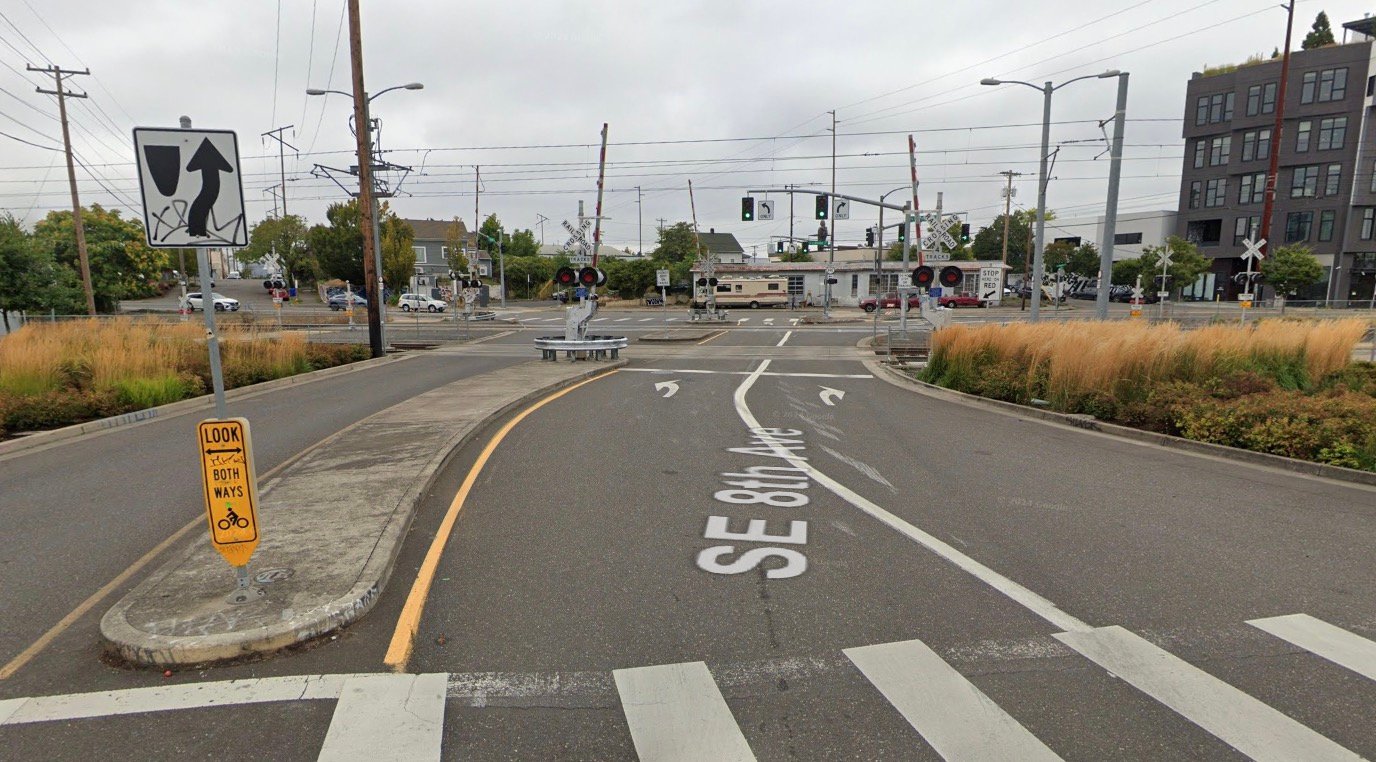
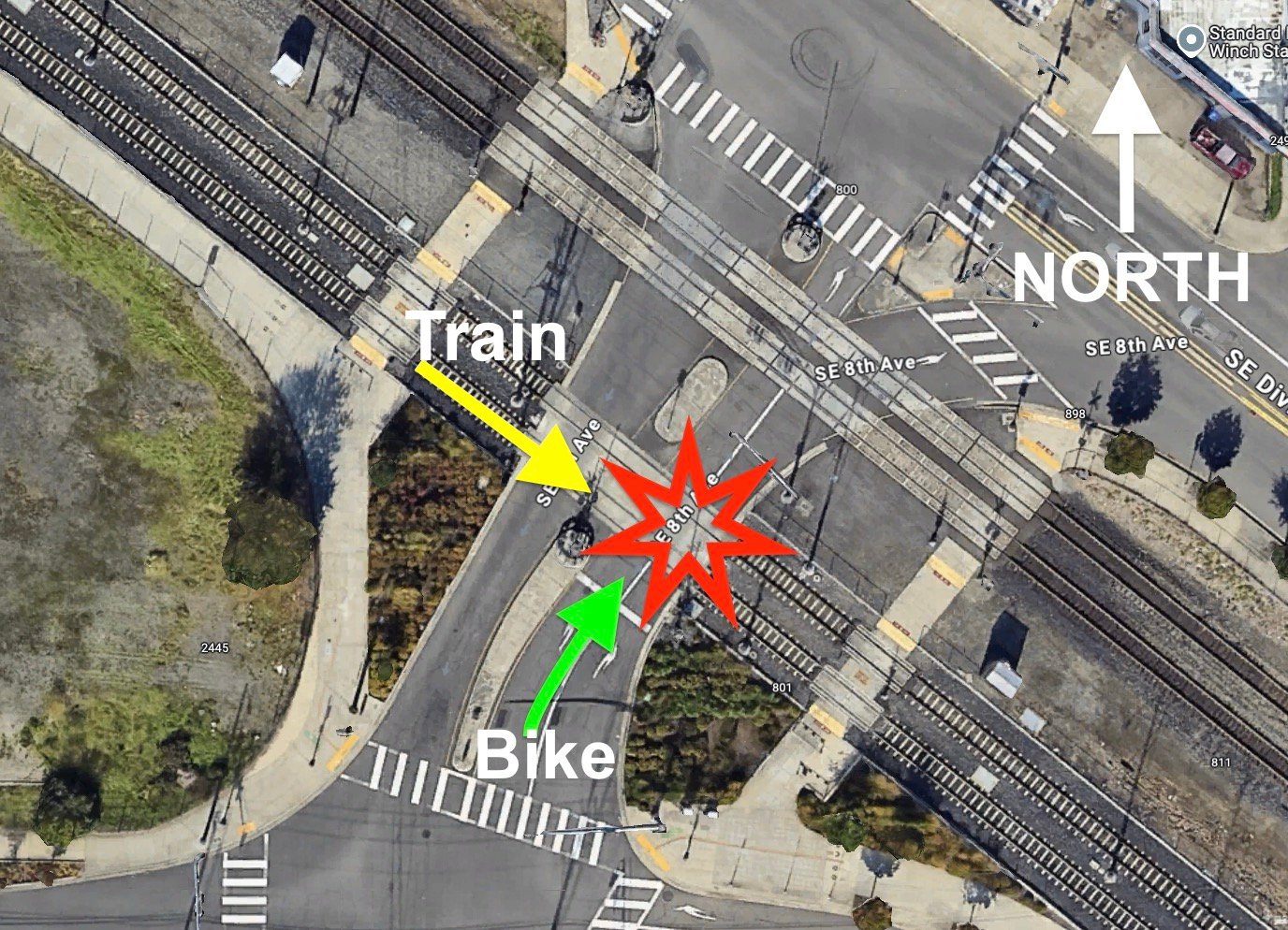
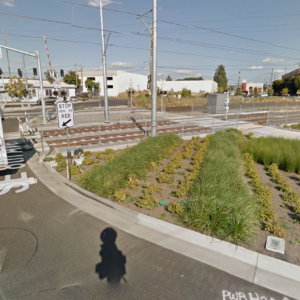
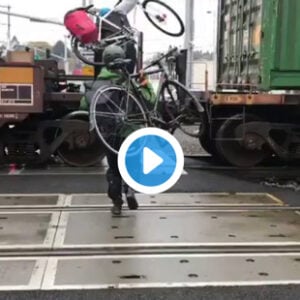
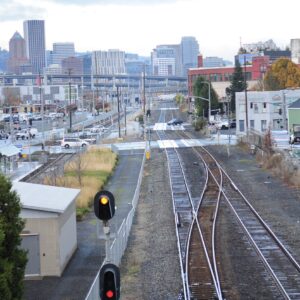
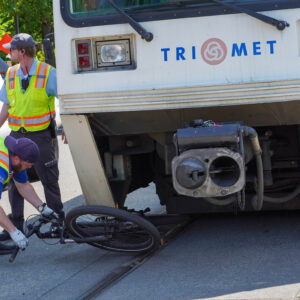
Thanks for reading.
BikePortland has served this community with independent community journalism since 2005. We rely on subscriptions from readers like you to survive. Your financial support is vital in keeping this valuable resource alive and well.
Please subscribe today to strengthen and expand our work.
I rode past as the 2nd fire rescue was arriving on-scene.
The Max train was headed East toward Gresham and was in the furthest South Tri-Met line of the 4 tracks.
There was a white ball-cap(and some misc other debris) in the northbound car lane on SE 8th Ave. and the cyclist was dragged East from the crossing before the MAX train stopped with the cyclist on the South side of the train outside the rail pinned under one of the MAX cars.
Even if there had been a UP freight train, that would have not obscured the cyclist view of the MAX train. Perhaps there was an approaching UP train that they were racing to beat and had tunnel vision on the UP locomotive. Or they were just trying to beat the MAX train at the very last second, going North in the Southbound lane to avoid the crossing arm.
The MAX train should have cameras that would answer most of these questions. Tragic for all involved.
That train goes to Milwaukie.
I feel terrible for the person that was killed and the people that care about them. Such a senseless and tragic mistake.
When I heard about it yesterday I’d just assumed it was a case of one train masking another.
We’ll never know what was going on in his mind at the time he decided to cross, it’s just sad that it resulted in about the worst possible outcome.
Having been the person left behind by a loved one’s decision, I feel tremendous empathy for his family and friends, as well as the MAX operator – they all have some tough times ahead and deserve our compassion.
I also saw a report that the investigators said the cyclist was Northbound in the southbound car lane, supporting your statement here. I think the image Jonathan made with him NB in the NB lane is not accurate based on recounts I’ve heard from neighbors and social media. Awful incident regardless of fault, the last thing I want to do is victim blame here.
My only intention w the image was to show the general direction of the rider’s movements. I’m aware that witness accounts say he went around the railings and might have been in the southbound lanes prior to entering the tracks.
Willfully disregarding traffic signals and train horns/sounds kind of precludes one from being a victim.
Harsh. Implying willful disregard seems a bit presumptuous. Redefining the word victim does not make a death by train collision less regrettable.
“Implying willful disregard seems a bit presumptuous.”
Do you see any plausible scenario where the cyclist did not intentionally ignore the warning signals? It may be presumptuous, but it is also by far the most likely explanation.
Maybe they had a medical issue right at that moment and their senses were adversely affected?
Then that’s not a problem of the infrastructure. It’s an extreme outlier.
Sad news.
I ride through this intersection constantly and the grimmest intrusive thoughts always cross my mind when it’s time to ride over the tracks. It just takes one inattentive and overly confident and impatient decision to let yourself go when you should just stop and wait. Anyone is capable of this kind of error.
In an ideal world the freight tracks would be in a tunnel and the MAX would be either a subway or on an elevated ROW. Or, at the very least, a ramp-only bike/pedestrian over or under pass would be at this intersection and at 12th.
In this world, it really is the responsibility of cyclists and pedestrians to not let the trains get the better of them and disregard the gates or assume its only a MAX or only an Amtrak or UP train coming through. If you need to keep moving, detour to the Bob Stacy Crossing, elevators be damned, or back track to the Eastbank Esplanade and go over the Hawthorn viaduct. Just like there are no good drivers, just good driving – there are no good cyclists, just good cycling.
The UP tracks can’t really go in a tunnel and still manage acceptable grades. The constraints of the Brooklyn Yard (and the bridge over Powell) and the Steel Bridge Junction make it too difficult. A viaduct would probably be more practical, but also extremely difficult – but viaducts have an advantage of not needing as much vertical clearance
Blum, do you know if PBOT was able to keep the Federal funding it got to study grade separation in this area?
I haven’t heard otherwise, but I have pretty low hopes of something getting built at 8th, and even lower hopes at 11th/12th. Between 8th and the double junction with the line east to Idaho and the Steel Bridge, there are multiple viaducts which prevent a viaduct grade crossing (you would need something like a 2.5% grade to get even close to acceptable clearances between the crossing at 8th and the MLK viaducts). A trench may be more feasible, but would need at least 25 feet of clearance from the street level. At a 1% grade, this would necessitate closing the crossing at Stark, Washington, and Alder in the Central Eastside, while on the other side (constrained by the Powell overcrossing), a 1% grade would necessitate closing 11th/12th (8th barely squeaks by).
I believe the only solution would be a multimodal street overpass at 7th, where one side is already up high, and land is available on the other.
A trench is not feasible — the grades are problematic, and if you were going to build it, you’d need to put it where the Orange Line is today. You can’t just close the UPRR line for a year while you build it, and I doubt TriMet would close and rebuild the Orange Line.
And who would pay for it?
Most likely the feds would have to pay for it, but technically raising the railroads is “easier” while slightly lowering the adjacent streets around 5 feet or so, so that local semis can go under the tracks, for 8th and 12th/13th. Likely a nearby MAX stop would also have to be rebuilt. I’ve seen this done elsewhere in the last 20 years.
A certain number of level crossings are apparently “required” to allow the railroad companies to access the tracks with repair pickup trucks (the kind that go on tracks) as well as moving certain hazardous (explosive) materials by truck, but quite likely there are other crossings they could use.
Not if you spend 5 seconds thinking about what trains are known to do to the human body. Cycling dead is impossible, but thinking about how hard it is without legs, an arm, even just getting lucky and losing a hand is a great way to put on the brakes, and follow all your advice of being patient or finding any one of a number of alternative routes.
Maybe it is because my dad was a railroader for 35 years and I am full of horrible stories contributing to a negativity bias, but there are too many (stupid) people who think these things are Thomas the Train choo choos. They are death and dismemberment perfected and should be treated as such.
Wow – kinda harsh.
Which part?
reality often is…
Reality does not have emotions or the capability to feel empathy. Moderates, centrists, and conservatives, on the other hand, often lack any semblance of basic human empathy.
PS has obviously never made a human error that put them at increased risk while driving, walking or rolling. Clearly, we should just abandon all nanny-state funding of traffic safety infrastructure and all try very, very hard to be a Galtian non-victim like PS.
I think this sums it up. C.O.t.W.
I’ll echo what Adam said. I ride through this section 2x/day commuting to/from South Waterfront, and have been afraid of what a moment’s impatience or inattentiveness could lead to. I went through yesterday just after 2 PM, when the Max train was still on the tracks, emergency personnel on scene, and more TriMet blue shirts on site than I’ve ever seen in my life. It was grim.
I’m not putting any blame on Trimet, but one thing that might help here is a speed limit on Max trains of 10 or 15 mph from the Tilikum to the Bob Stacey crossing, and operators blowing the horn before all crossings (the freight trains already do this).
My heartfelt condolences to all affected by this tragedy.
Yeah, I go through here all the time, east-west. When the crossing arms are down, I look to see where the train they’re for is. Sometimes it’s a UP train that’s still a couple minutes from the intersection, or sometimes it’s the MAX train that’s just passed. I still look for trains coming from the other direction even if I’ve spotted one. But I still think the MAX blowing its horn at these crossings might be helpful.
4 way gates would be better than adding 4-5 minutes to everyone’s commute and reducing the usefulness of the Max trains.
Look, they’re already horribly slow and inefficient and you want to make them slower?
If ridership doesn’t rebound the entire Trimet system may have to be just shutdown. They have lost 1/3 of pre-pandemic ridership and one of the lowest ridership of any city of its size.
In any case, even in very safe countries like Japan with multiple crossing gates and alarms, there are still an ongoing number of casualties from train accidents. Which is why they are attempting to grade separate EVERYTHING.
Maybe the solution is to not ride across the tracks with a train present
As someone who now lives within a few blocks of these crossings, there’s a reason there’s a horn-blowing exemption for both the Max and UPRR at these intersections. You definitely can say “you chose to live here”, but the noise pollution and very loud interruption to both residents and business due to these horns would not be trivial. At Islabikes we often would have to pause phone conversations with customers when the train horn was blowing — it was that loud.
I do wonder if the persistent unknown as to if the Bob Stacey elevators are working OR if they are filled with folks who may be high (so it feels very unsafe to share confined space with) is a contributing factor here. If you can’t rely on a crossing when a train is blocking the tracks, then you just might make a terrible, life ending decision to try to beat it.
No. MAX is already slow enough. Why would you have MAX trains poking along at less than a cycling pace at a grade crossing that gets 40+mph Amtrak trains?
We should have quad gates on the main road and gates at the pedestrian crossings here.
There is a problem with how long the signal stays active after a train is finished crossing. People are trained to ignore the warning since it usually keeps going for a long time after the crossing is clear. There should be a limit of 3 seconds or something from when a train is physically clear of the crossing to when the signal stops. Then if it kept going people would know another train was coming and take it seriously.
Well, people should always look in both directions and not just assume one crossing arm down = one train. Might be hard to reminder there’s two kinds of trains in both directions, though?
“not just assume one crossing arm down = one train”
Much of Portland’s bike path design presumes that people are familiar with the route they are using or the eccentricities of Portland. This is a mistake, particularly in the central areas, given that biking is a popular method of tourists traveling through and experiencing the city.
This is especially true when the 1st train through is on the nearer of the 2 tracks – it can easily mask the train coming from the opposite direction.
The MAX crossing of SW 117th is a case in point: Because WB MAX trains are coming from around a bend it is very possible for it not to be in sight when an EB train goes by (moving a bit slowly having just come out of BTC) and for it to be right on top of the crossing when the EB train clears the crossing.
This is heartbreaking and close to home. I ride through this section all the time.
While the cyclist likely acted in a dangerous way, the choice to route the Orange Line along the UP tracks here was always going to invite this kind of danger. With so many long freight delays, it’s easy to forget about the MAX, and it just makes me wish the Orange Line would have been routed down McLoughlin rather than up and around via the UP tracks. There’s drawbacks to every transit line routing choice, but given the dangerous situation at this crossing and at 11th/12th/Milwaukie, it feels like we might have gotten this one wrong. Hopefully this will give the impetus for better safety features at the crossings, though I’m not entirely sure what more can be done
Here are a few ideas:
Those are just two ideas. I’m sure there are many more. Portland is just so pathetic and disappointing at most times.
Grade separating the line is possible, but will never happen without significant public investment, which seems as far as way as it’s ever been.
On the second point, I suppose it’s cost again. I don’t think anything short of closing the crossing would be a budget-acceptable way of dealing with the kind of safety issue presented here. Overcrossings are generally out of the way, and if you are rushing through a rail crossing with barriers down surely you aren’t just going over to the overcrossing.
Right — no one would ride from 8th to 13th then up and over and back to avoid a sub-30 second Max delay.
The rail line was here before the city so I doubt UP has any reason to concede their right of way that has been established for well over a century.
I think you are also ignoring the complexity of the elevator situation of the over crossings. These are routinely getting vandalized and borderline destroyed. It’s not the inability to operate an elevator but keeping up with the destruction that seems to plague our public infrastructure.
It’s truly one of the least complex problems the City faces. The decision to build elevators was a mistake. Ramps will be operational 100% of the time.
At risk of being needlessly pedantic, this isn’t entirely true. East Portland was platted and developed before the east side line of the Oregon Central Railroad (which is the current UP line) was built in 1869. The area around the line certainly developed much faster after the railroad was built, but the reason for the proliferation of grade crossings between the Steel Bridge and Powell has more to do with the surrounding warehousing and manufacturing uses from 1870 to the 1950s than anything else.
“Not have the West-Coast main line for trains (passenger AND freight!) run at grade level through a major American city”
Third idea: not build a city around an existing at grade passenger and freight line without building crossings.
I know the usual crew will accuse me of victim blaming, but lots more can be done. Independent crossing arms for Max and UP. Lights or signals showing which tracks are active when existing arms are down. Crossing arms in both directions to make it harder to ride around. Directions to use the MLK Viaduct (closest crossing to 8th) when the route is blocked. Arms back up more quickly after train had passed (I’d even start raising when Max train was still slightly in the street). All relatively cheap options.
Without knowing more about what happened here, it’s not obvious any of these would have helped, but all could help avoid the next tragedy.
Some of these can and should be done – especially double arms and pedestrian arms. I’m not certain enough to comment more, but I think there are some serious constraints with how quickly the arms can re-raise based on the physical reality of railroad signals, plus the regulatory environment complicates things further.
More signals probably won’t help when you’re telling people to “ignore the signals” on this street specifically. Whoops, I guess.
I never said that about the crossing at 8th, but I stand by what I said if you ride along the bike path. If the arms are down, be very very careful bypassing them. Obviously.
But I’m glad you agree with my point… Because the signals are so misdesigned, people learn to ignore them, occasionally with traffic results.
The original design for the South/North MAX line that was voted down by regional voters in 1998 called for a grade separated crossing here. Saving money sometimes costs lives.
That’s a nice bit of trivia, but this tragedy is the result of poor human judgment and impatient behavior. Don’t blame designers, engineers, voters, and politicians from nearly 30 years ago for this incident. My rides and runs cause me to cross MAX and train tracks with frequency. I obey the warnings and the signals. Life isn’t worth risking for Strava kudos or a few saved moments.
What you can absolutely blame past decisions by engineers and politicians for creating more dangerous roadways. They knew this design would be more dangerous because humans aren’t perfect but they chose to go with it to save money. There’s legal precedent for this.
Obviously this cyclist is at least partially at fault but this is a very dangerous area and we chose to build a less optimal design to save money. We even chose a second time to save money over safety when pedestrian bridges suggested for this spot and at 12th were killed to save money.
How is it very dangerous area? How many freight trains, light rail trains, cars, trucks and pedestrians/cyclists use it every day without issue? The type of rider who will go into the wrong lane to avoid a lowered barrier was not going to be climbing stairs/ramp to a pedestrian bridge and the type of people who would use the pedestrian bridge will just wait for the train to pass, or pursue another route. The diminishing returns of safety will always leave us chasing the lowest common denominator user who for whatever reason doesn’t want to follow conventions or rules.
There was never a serious proposal for pedestrian bridges at 11th and 12th.
Yeah, folks are making this way more complicated than it is
Safe behavior around rail crossings is critical, but I think there’s some general blame related to the design of the segment of the Orange Line between OMSI and Powell. The combination of frequent long freight trains with a light rail train every 7.5 minutes makes people do risky things, even if they shouldn’t. It’s inherent to the choice of routing, and the fact that the project spent many hundreds of millions on grade separation elsewhere makes this choice especially frustrating in hindsight (just look at the structures that carry the line over and around the Tacoma/99E junction and the one carrying the line over the P&W branch to Lake O on the north side of Milwaukie). That’s more to do with the planning and design of what we got, but that is all downstream of the failed 1990s proposals (which all failed because of voters in Clark County)
Crossing Powell is far more dangerous than crossing the tracks.
I think the “original design” of what is now the Orange Line is probably more accurately described as the PRL&P interurban line to Oregon City (which is now made up by the Springwater Corridor and Trolley Trails), since public planning for this line began as early as the late 1970s, while that line was still intact. After that, routing along McLoughlin were strongly considered, though I can’t find the specific source on that right now (I think it’s in the 2010 LPA, but not sure). Neither of those would have had a crossing of any kind at 8th (instead following McLoughlin to the Hawthorne Bridge or a new bridge slightly further north of where the Tilikum was built).
And the 1998 South/North line passed by two-thirds in Oregon before losing by 2/3rds in Clark Co. I’m less familiar with the specifics of the alignment than I’d like to be, but there are so many missed opportunities with transit funding in the US that it’s hard to know where to begin. But either way, I wouldn’t boil 1990s Clark Co anti-light rail sentiment to be purely “saving money”, nor would I boil current anti-light rail sentiment in Clark Co to that now.
Laying blame to voters in 1998 for this tragedy is a disappointing choice. This entire segment was reconstructed for the orange line, we’ve run the FX2 through here as well, plenty of blame to go around but old unfunded plans are not the problem here.
I passed by on FX2 later in the afternoon when the MAX was still in place and a plethora of emergency vehicles on the scene. FX2 must detour whenever a UP train occupies the crossing, and in this case too with the TriMet unit still blocking Eighth.
If the cyclist did not see the MAX (on its way to Milwaukie, not Gresham) it may be that TriMet’s new dark blue color scheme contributed to that. It is noticeably harder to see dark trains and busses than light ones. They can alarm riders when pulling into a stop and when pedestrians and motorists must cross in front of them.
Were ergonomic conditions affecting safety even considered when that color scheme was chosen?
I’m still really disappointed in the planning behind that area.
Being on an FX (Frequent eXpress) and having it turn 20 times to get over to the OMSI stop is painful enough (yes, I know it’s not actually 20, but it sure feels like it). The fact that a 58 year old cyclist can easily ride from OMSI to 5th and Main faster than either the Orange line or FX is even worse.
Are MAX trains not required to run with lights at all times? Now I’m going to have to look to see if they ever don’t.
Heck, I think every motor vehicle should be required to run with lights 24/7, but that’s me.
“Are MAX trains not required to run with lights at all times?”
Max trains are always well lit. Visibility was not the primary factor here.
That’s what I thought. I just get so used to it that I thought maybe I had missed it when they don’t.
Also, I’m fairly sure that when MAX trains cross roads with barriers (117th, Flavel come to mind) they ring their bell.
The operator also sounds the bell anytime they see someone who isn’t apparently paying attention.
Seriously, they probably didn’t adequately plan for people that would ignore every single other safety measure, including the redundancies, and the mistake was that all the trains aren’t wrapped in dayglo orange, green and pink.
And when people get hit by hi-viz trains?
BNSF trains are bright orange, and still kill people regularly. I don’t think color is a factor here. Usually impairment is a bigger factor.
Obtuse.
Every aspect of system design contributes to safety or lack thereof.
The MAX system is predicated on sharing public rights-of-way and intruding on it.
Example 1: The crossing of Baseline Road between Elmonica and Willow Creek. Trains cross this diagonally, with poor sight-lines for motorists, at full speed (55 miles/hour) separated only by the same sort of guards as at Eighth. With extension of the Red Line to Airport/Fairgrounds those actuate every 3 to 4 minutes, creating potentially major conflict 15 to 20 times every hour. This begs for a grade-separated crossing.
Example 2: The remote station at Beaverton Creek. The nearest road is 200 yards Southwest, crossing the tracks 1/4 mile in the direction of Hillsboro. Tracks run adjacent to a deep pine forest, “Nike Woods;” corporate headquarters are just beyond. There are many walkers, runners, cyclists, (frequent BIKETOWN traffic) entering and exiting the Woods, necessarily across the tracks; their safety is wholly predicated upon being able to see stopped or approaching trains, again every 3 to 4 minutes. Not at all trivial. White trains are much easier to see than blue trains.
And the dark blue livery is by far the ugliest TriMet ever has used.
“creating potentially major conflict 15 to 20 times every hour. This begs for a grade-separated crossing.”
Meanwhile we have streets where hundreds of thousands of vehicles cross each other’s path at-grade every day without incident.
Are there no crashes at all?
No loss of life?
Is design of transportation systems irrelevant?
Your statement is naive at most, or more likely silly.
There are so few train/poorly behaved pedestrian fatalities that it does not warrant the giant expenses you are calling for.
How many dollars is a human life worth to you, exactly?
In the US, a human life is worth around $10 million.
https://en.m.wikipedia.org/wiki/Value_of_life
“Are there no crashes at all?”
On a per interaction basis? Practically none.
Of course there could be improvements. Who could think otherwise?
58 people were killed in traffic crashes on Portland streets in 2024. Over 70% of those deaths occured on High Crash Network streets, which make up only 8% of all streets in the city. Is that what you mean by “without incident”?
How many interactions produced those figures?
It is pretty clear that Max trains are far more dangerous to cyclists than cars are. The only reason we don’t see more incidents is because there are so few train-bike interactions.
Feel free to ride your bike on the Banfield Expressway since cars are such a low risk to cyclists. Managing conflict between different modes takes careful planning, but it doesn’t mean we have to give up all the other advantages public transportation offers.
Every road fatality is – quite literally – a human sacrifice to sustain our dysfunctional transportation system.
You can listen to radio communications about the incident here:
http://www.rosecitytransit.org/radio/?1767+5418+2025-6-18
Fire response https://openmhz.com/system/pdx2?filter-type=talkgroup&filter-code=293
Reddit discussion https://old.reddit.com/r/Portland/comments/1let42f/bicyclist_struck_killed_by_max_train_in_se/
https://www.koin.com/news/portland/cyclist-who-died-in-tragic-collision-with-max-train-identified-as-former-portland-mayoral-candidate/
Tragic no matter who it was but this is the person who died.
More about Mike O’Callahan
https://mayormikeoc.com/meet-mike/
I think he attended at least one Bike Happy Hour during the campaign? Not sure though.
yes, like I shared in an update earlier today, Mike was a regular at Bike Happy Hour and spoke at open mic several times.
So sad to hear about Michael Callahan’s end. RIP
Have often seen Michael’s bike while riding up and down the Springwater. Devastating news.
The Gideon/Bob Stacey ped & bike crossing just past the Clinton St./ SE 12th MAX station is a nice safe option for crossing the tracks.